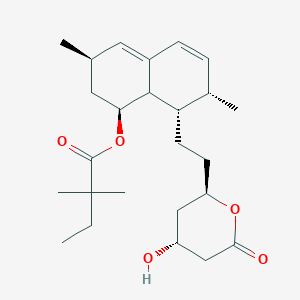
Simvastatin
Übersicht
Beschreibung
Simvastatin ist ein lipidsenkendes Medikament, das zur Klasse der Statine gehört. Es wird hauptsächlich verwendet, um erhöhte Lipidspiegel zu senken und das Risiko von Herz-Kreislauf-Ereignissen wie Herzinfarkten und Schlaganfällen zu verringern. This compound wirkt, indem es das Enzym Hydroxymethylglutaryl-Coenzym A (HMG-CoA)-Reduktase hemmt, das eine entscheidende Rolle bei der Cholesterinbiosynthese spielt .
Wirkmechanismus
Target of Action
Simvastatin primarily targets the enzyme 3-hydroxy-3-methylglutaryl-coenzyme A (HMG-CoA) reductase . This enzyme plays a crucial role in the endogenous production of cholesterol in the liver .
Mode of Action
This compound acts by competitively inhibiting HMG-CoA reductase . This inhibition prevents the conversion of HMG-CoA to mevalonic acid, which is the third step in a sequence of metabolic reactions involved in the production of several compounds involved in lipid metabolism and transport, including cholesterol, low-density lipoprotein (LDL), and very low-density lipoprotein (VLDL) .
Biochemical Pathways
The inhibition of HMG-CoA reductase by this compound disrupts the mevalonate pathway . This leads to a decrease in the production of cholesterol and other lipid compounds, resulting in lower levels of LDL and VLDL . Additionally, some of the effects of this compound in proteostasis lead to reduced levels of amyloid beta .
Pharmacokinetics
This compound is absorbed orally, with about 85% being absorbed following administration . Less than 5% reaches the general circulation due to an extensive first-pass effect . It is metabolized in the liver via the CYP3A4 enzyme . The drug is mainly excreted in the feces (60%) and urine (13%) .
Result of Action
The primary result of this compound’s action is a significant reduction in LDL and VLDL levels . This leads to a decrease in total cholesterol levels, which is beneficial in managing abnormal lipid levels and reducing the risk of cardiovascular disease . Furthermore, this compound has been shown to significantly reduce the risk of development of cardiovascular disease and all-cause mortality .
Action Environment
The action of this compound can be influenced by various environmental factors. For instance, the presence of certain bile acids can augment the bioaccumulation of this compound in bacteria cells . Additionally, polymorphisms in the CYP3A5 gene can affect the disposition of this compound, potentially explaining interindividual variability in this compound disposition and pharmacokinetics .
Biochemische Analyse
Biochemical Properties
Simvastatin interacts with the enzyme HMG-CoA reductase, which is the key rate-limiting enzyme in the cholesterol biosynthetic pathway . By competitively inhibiting this enzyme, this compound not only reduces the cellular production of cholesterol but also affects the biosynthesis of several intermediates of the mevalonate pathway, such as farnesylpyrophosphate and geranylgeranylpyrophosphate .
Cellular Effects
This compound has been shown to have profound effects on various types of cells and cellular processes. For instance, it has been found to inhibit glucose metabolism and legumain activity in human myotubes . It also exerts inhibitory effects on the NLRP3 inflammasome and toll-like receptors, which are implicated in inflammation and atherosclerosis .
Molecular Mechanism
This compound exerts its effects at the molecular level by inhibiting the conversion of HMG-CoA to mevalonic acid, a key step in the cholesterol synthesis pathway . This inhibition is achieved by the competitive inhibition of the enzyme HMG-CoA reductase . Furthermore, this compound can suppress TLR4/MyD88/NF-ĸB signaling and cause an immune response shift to an anti-inflammatory response .
Temporal Effects in Laboratory Settings
In laboratory settings, this compound has been shown to cause a dose-dependent decrease in both glucose uptake and oxidation in mature myotubes . Moreover, long-term studies indicate that little or no attenuation of these changes in serum lipid and lipoprotein levels occurred with administration of this compound for 3 to 5.4 years .
Dosage Effects in Animal Models
In animal models, this compound has been shown to cause bioaccumulation over time, which was augmented upon addition of bile acids . High doses of this compound have been associated with increased osteoporosis risk , and extensive muscle-specific damage, particularly in the organization of sarcomeres and in mitochondria .
Metabolic Pathways
This compound is involved in the cholesterol biosynthesis pathway, where it inhibits the conversion of HMG-CoA to mevalonic acid . This action not only inhibits the cellular production of cholesterol but also affects the biosynthesis of several intermediates of the mevalonate pathway .
Transport and Distribution
This compound is transported into bacteria cells leading to a drug bioaccumulation over time, which is augmented upon addition of bile acids . A decrease of total drug level during the incubation indicates that the drug is partly biotransformed by bacterial enzymes .
Subcellular Localization
This compound has been shown to cause alterations in the intracellular distribution of lysosomal cysteine proteases . In addition, protein isoprenylation permits the covalent attachment, subcellular localization, and intracellular trafficking of membrane-associated proteins .
Vorbereitungsmethoden
Simvastatin wird aus einem Fermentationsprodukt des Pilzes Aspergillus terreus synthetisiert. Der Syntheseweg umfasst mehrere wichtige Schritte:
Fermentation: Der erste Schritt beinhaltet die Fermentation von Aspergillus terreus, um die Vorläuferverbindung zu produzieren.
Chemische Modifikation: Die Vorläuferverbindung wird chemisch modifiziert, einschließlich Veresterung und Lactonisierung, um this compound zu bilden.
Industrielle Produktionsmethoden konzentrieren sich darauf, diese Schritte zu optimieren, um eine hohe Ausbeute und Reinheit zu gewährleisten. Der Prozess beinhaltet eine strenge Kontrolle der Reaktionsbedingungen wie Temperatur, pH-Wert und Lösungsmittelverwendung, um das gewünschte Produkt zu erhalten.
Analyse Chemischer Reaktionen
Simvastatin unterliegt verschiedenen Arten von chemischen Reaktionen:
Reduktion und Substitution: Diese Reaktionen sind weniger häufig, können aber unter bestimmten Bedingungen auftreten.
Häufig verwendete Reagenzien in diesen Reaktionen sind Wasser für die Hydrolyse und Cytochrom-P450-Enzyme für die Oxidation. Die wichtigsten gebildeten Produkte umfassen die aktive β-Hydroxy-Säureform und verschiedene oxidierte Metaboliten.
Wissenschaftliche Forschungsanwendungen
Simvastatin hat eine breite Palette von Anwendungen in der wissenschaftlichen Forschung:
Knochenregeneration: Forschungen haben gezeigt, dass this compound die Knochenregeneration fördern kann, was es zu einer potenziellen Behandlung für Erkrankungen wie Osteoporose macht.
Antimikrobielle Eigenschaften: This compound hat antimikrobielle Wirkungen gezeigt, die für potenzielle therapeutische Anwendungen untersucht werden.
5. Wirkmechanismus
This compound übt seine Wirkungen aus, indem es kompetitiv die HMG-CoA-Reduktase hemmt, das Enzym, das für die Umwandlung von HMG-CoA in Mevalonsäure, einem Vorläufer in der Cholesterinbiosynthese, verantwortlich ist . Diese Hemmung führt zu einer Abnahme der Cholesterinsynthese in der Leber, was zu niedrigeren Spiegeln an Low-Density-Lipoprotein (LDL)-Cholesterin im Blut führt. Darüber hinaus hat this compound pleiotrope Wirkungen, einschließlich entzündungshemmender und antioxidativer Eigenschaften .
Vergleich Mit ähnlichen Verbindungen
Simvastatin wird oft mit anderen Statinen wie Atorvastatin, Rosuvastatin, Pravastatin, Fluvastatin und Lovastatin verglichen. Obwohl alle diese Verbindungen einen ähnlichen Wirkmechanismus aufweisen, unterscheiden sie sich in ihren pharmakokinetischen Eigenschaften, ihrer Potenz und ihrem Nebenwirkungsprofil . Zum Beispiel:
Atorvastatin: Bekannt für seine hohe Potenz und längere Halbwertszeit im Vergleich zu this compound.
Rosuvastatin: Hat eine höhere Wirksamkeit bei der Senkung des LDL-Cholesterinspiegels, kann aber mehr muskelbedingte Nebenwirkungen verursachen.
Pravastatin: Weniger lipophil und hat im Vergleich zu this compound weniger Arzneimittelwechselwirkungen.
Die einzigartige Fähigkeit von this compound, die Blut-Hirn-Schranke zu überwinden, und sein weit verbreiteter Einsatz in der Behandlung von Herz-Kreislauf-Erkrankungen unterstreichen seine besonderen Vorteile .
Eigenschaften
IUPAC Name |
[(1S,3R,7S,8S,8aR)-8-[2-[(2R,4R)-4-hydroxy-6-oxooxan-2-yl]ethyl]-3,7-dimethyl-1,2,3,7,8,8a-hexahydronaphthalen-1-yl] 2,2-dimethylbutanoate | |
|---|---|---|
| Source | PubChem | |
| URL | https://pubchem.ncbi.nlm.nih.gov | |
| Description | Data deposited in or computed by PubChem | |
InChI |
InChI=1S/C25H38O5/c1-6-25(4,5)24(28)30-21-12-15(2)11-17-8-7-16(3)20(23(17)21)10-9-19-13-18(26)14-22(27)29-19/h7-8,11,15-16,18-21,23,26H,6,9-10,12-14H2,1-5H3/t15-,16-,18+,19+,20-,21-,23-/m0/s1 | |
| Source | PubChem | |
| URL | https://pubchem.ncbi.nlm.nih.gov | |
| Description | Data deposited in or computed by PubChem | |
InChI Key |
RYMZZMVNJRMUDD-HGQWONQESA-N | |
| Source | PubChem | |
| URL | https://pubchem.ncbi.nlm.nih.gov | |
| Description | Data deposited in or computed by PubChem | |
Canonical SMILES |
CCC(C)(C)C(=O)OC1CC(C=C2C1C(C(C=C2)C)CCC3CC(CC(=O)O3)O)C | |
| Source | PubChem | |
| URL | https://pubchem.ncbi.nlm.nih.gov | |
| Description | Data deposited in or computed by PubChem | |
Isomeric SMILES |
CCC(C)(C)C(=O)O[C@H]1C[C@H](C=C2[C@H]1[C@H]([C@H](C=C2)C)CC[C@@H]3C[C@H](CC(=O)O3)O)C | |
| Source | PubChem | |
| URL | https://pubchem.ncbi.nlm.nih.gov | |
| Description | Data deposited in or computed by PubChem | |
Molecular Formula |
C25H38O5 | |
| Source | PubChem | |
| URL | https://pubchem.ncbi.nlm.nih.gov | |
| Description | Data deposited in or computed by PubChem | |
DSSTOX Substance ID |
DTXSID0023581 | |
| Record name | Simvastatin | |
| Source | EPA DSSTox | |
| URL | https://comptox.epa.gov/dashboard/DTXSID0023581 | |
| Description | DSSTox provides a high quality public chemistry resource for supporting improved predictive toxicology. | |
Molecular Weight |
418.6 g/mol | |
| Source | PubChem | |
| URL | https://pubchem.ncbi.nlm.nih.gov | |
| Description | Data deposited in or computed by PubChem | |
Physical Description |
Solid | |
| Record name | Simvastatin | |
| Source | Human Metabolome Database (HMDB) | |
| URL | http://www.hmdb.ca/metabolites/HMDB0005007 | |
| Description | The Human Metabolome Database (HMDB) is a freely available electronic database containing detailed information about small molecule metabolites found in the human body. | |
| Explanation | HMDB is offered to the public as a freely available resource. Use and re-distribution of the data, in whole or in part, for commercial purposes requires explicit permission of the authors and explicit acknowledgment of the source material (HMDB) and the original publication (see the HMDB citing page). We ask that users who download significant portions of the database cite the HMDB paper in any resulting publications. | |
Solubility |
Insoluble, In water, 3.0X10-2 mg/L, temp not specified, Solubility (mg/mL): chloroform 610; DMSO 540; methanol 200; ethanol 160; n-hexane 0.15; 0.1 M HCl 0.06; polyethylene glycol-400 70; propylene glycol 30; 0.1 M NaOH 70, 1.22e-02 g/L | |
| Record name | Simvastatin | |
| Source | DrugBank | |
| URL | https://www.drugbank.ca/drugs/DB00641 | |
| Description | The DrugBank database is a unique bioinformatics and cheminformatics resource that combines detailed drug (i.e. chemical, pharmacological and pharmaceutical) data with comprehensive drug target (i.e. sequence, structure, and pathway) information. | |
| Explanation | Creative Common's Attribution-NonCommercial 4.0 International License (http://creativecommons.org/licenses/by-nc/4.0/legalcode) | |
| Record name | Simvastatin | |
| Source | Hazardous Substances Data Bank (HSDB) | |
| URL | https://pubchem.ncbi.nlm.nih.gov/source/hsdb/7208 | |
| Description | The Hazardous Substances Data Bank (HSDB) is a toxicology database that focuses on the toxicology of potentially hazardous chemicals. It provides information on human exposure, industrial hygiene, emergency handling procedures, environmental fate, regulatory requirements, nanomaterials, and related areas. The information in HSDB has been assessed by a Scientific Review Panel. | |
| Record name | Simvastatin | |
| Source | Human Metabolome Database (HMDB) | |
| URL | http://www.hmdb.ca/metabolites/HMDB0005007 | |
| Description | The Human Metabolome Database (HMDB) is a freely available electronic database containing detailed information about small molecule metabolites found in the human body. | |
| Explanation | HMDB is offered to the public as a freely available resource. Use and re-distribution of the data, in whole or in part, for commercial purposes requires explicit permission of the authors and explicit acknowledgment of the source material (HMDB) and the original publication (see the HMDB citing page). We ask that users who download significant portions of the database cite the HMDB paper in any resulting publications. | |
Mechanism of Action |
Simvastatin is a prodrug in which the 6-membered lactone ring of simvastatin is hydrolyzed in vivo to generate the beta,delta-dihydroxy acid, an active metabolite structurally similar to HMG-CoA (hydroxymethylglutaryl CoA). Once hydrolyzed, simvastatin competes with HMG-CoA for HMG-CoA reductase, a hepatic microsomal enzyme, which catalyzes the conversion of HMG-CoA to mevalonate, an early rate-limiting step in cholesterol biosynthesis. Simvastatin acts primarily in the liver, where decreased hepatic cholesterol concentrations stimulate the upregulation of hepatic low density lipoprotein (LDL) receptors which increases hepatic uptake of LDL. Simvastatin also inhibits hepatic synthesis of very low density lipoprotein (VLDL). The overall effect is a decrease in plasma LDL and VLDL. At therapeutic doses, the HMG-CoA enzyme is not completely blocked by simvastatin activity, thereby allowing biologically necessary amounts of mevalonate to remain available. As mevalonate is an early step in the biosynthetic pathway for cholesterol, therapy with simvastatin would also not be expected to cause any accumulation of potentially toxic sterols. In addition, HMG-CoA is metabolized readily back to acetyl-CoA, which participates in many biosynthetic processes in the body. In vitro and in vivo animal studies also demonstrate that simvastatin exerts vasculoprotective effects independent of its lipid-lowering properties, also known as the pleiotropic effects of statins. This includes improvement in endothelial function, enhanced stability of atherosclerotic plaques, reduced oxidative stress and inflammation, and inhibition of the thrombogenic response. Statins have also been found to bind allosterically to β2 integrin function-associated antigen-1 (LFA-1), which plays an important role in leukocyte trafficking and in T cell activation., Simvastatin is a prodrug and is hydrolyzed to its active beta-hydroxyacid form, simvastatin acid, after administration. Simvastatin is a specific inhibitor of 3-hydroxy-3-methylglutaryl-coenzyme A (HMG-CoA) reductase, the enzyme that catalyzes the conversion of HMG-CoA to mevalonate, an early and rate limiting step in the biosynthetic pathway for cholesterol. In addition, simvastatin reduces VLDL and TG and increases HDL-C., The HDL-associated enzyme paraoxonase protects LDLs from oxidative stress. 3-Hydroxy-3-methylglutaryl coenzyme A reductase inhibitors (statins) appear to favorably influence the atherosclerotic process by different mechanisms. The present study examined the influence of simvastatin on paraoxonase expression and serum paraoxonase levels. Simvastatin upregulated in a dose-dependent manner the activity of the promoter of the paraoxonase gene in expression cassettes transfected into HepG2 cells. Upregulation could be blocked by mevalonate and other intermediates of the cholesterol biosynthetic pathway. Simvastatin increased nuclear factors, notably sterol regulatory element-binding protein-2, capable of binding to the paraoxonase promoter; this was also blocked by mevalonate. Sterol regulatory element-binding protein-2 upregulated promoter activity in vitro. Patients treated with statin showed a significant increase in serum concentrations and activities of paraoxonase. The data indicate that simvastatin can modulate expression in vitro of the antioxidant enzyme paraoxonase and is associated with increased serum paraoxonase concentration and activity. It is consistent with effects of simvastatin treatment, which have the potential to influence beneficially antiatherogenic mechanisms at the HDL level. The study provides evidence for 1 molecular mechanism by which paraoxonase gene expression could be regulated., ... We report in this work that, unexpectedly, simvastatin enhances LPS-induced IL-12p40 production by murine macrophages, and that it does so by activating the IL-12p40 promoter. Mutational analysis and dominant-negative expression studies indicate that both C/EBP and AP-1 transcription factors have a crucial role in promoter activation. This occurs via a c-Fos- and c-Jun-based mechanism; we demonstrate that ectopic expression of c-Jun activates the IL-12p40 promoter, whereas expression of c-Fos inhibits IL-12p40 promoter activity. Simvastatin prevents LPS-induced c-Fos expression, thereby relieving the inhibitory effect of c-Fos on the IL-12p40 promoter. Concomitantly, simvastatin induces the phosphorylation of c-Jun by the c-Jun N-terminal kinase, resulting in c-Jun-dependent activation of the IL-12p40 promoter. This appears to be a general mechanism because simvastatin also augments LPS-dependent activation of the TNF-alpha promoter, perhaps because the TNF-alpha promoter has C/EBP and AP-1 binding sites in a similar configuration to the IL-12p40 promoter. The fact that simvastatin potently augments LPS-induced IL-12p40 and TNF-alpha production has implications for the treatment of bacterial infections in statin-treated patients., Statins are increasingly recognized as mediators of direct cellular effects independent of their lipid lowering capacity. Therefore, the time and concentration dependence of various statin-mediated cellular alterations was compared in renal mesangial cells. The effects of statins on cell proliferation, gene expression, cytoskeletal alterations, apoptosis, and cytotoxicity were analyzed in cultured mesangial cells using standard techniques. Results. Simvastatin and lovastatin decreased proliferation and cell number of rat mesangial cells concentration-dependently. Concurrently, the expression of the fibrogenic protein connective tissue growth factor (CTGF) was impaired and actin stress fibers, which are typical of mesangial cells in culture, became disassembled by simvastatin. A decrease of the posttranslational modification of RhoA by geranylgeranyl moieties was detected, supporting a role for RhoA as mediator of statin effects. Induction of apoptosis, determined by activation of caspase-3 and DNA fragmentation, and necrosis only occurred at later time points, when the morphology of the cells was strongly altered and the cells detached from the surface due to changes in the actin cytoskeleton. Basically, the same results were obtained with a human mesangial cell line. Furthermore, statin effects were mimicked by inhibition of the geranylgeranyltransferase. Most of the cellular effects of the lipophilic statins occurred within the same time and concentration range, suggesting a common molecular mechanism. Only apoptosis and necrosis were observed at later time points or with higher concentrations of simvastatin and thus seem to be secondary to the changes in gene expression and alterations of the actin cytoskeleton., For more Mechanism of Action (Complete) data for Simvastatin (6 total), please visit the HSDB record page. | |
| Record name | Simvastatin | |
| Source | DrugBank | |
| URL | https://www.drugbank.ca/drugs/DB00641 | |
| Description | The DrugBank database is a unique bioinformatics and cheminformatics resource that combines detailed drug (i.e. chemical, pharmacological and pharmaceutical) data with comprehensive drug target (i.e. sequence, structure, and pathway) information. | |
| Explanation | Creative Common's Attribution-NonCommercial 4.0 International License (http://creativecommons.org/licenses/by-nc/4.0/legalcode) | |
| Record name | Simvastatin | |
| Source | Hazardous Substances Data Bank (HSDB) | |
| URL | https://pubchem.ncbi.nlm.nih.gov/source/hsdb/7208 | |
| Description | The Hazardous Substances Data Bank (HSDB) is a toxicology database that focuses on the toxicology of potentially hazardous chemicals. It provides information on human exposure, industrial hygiene, emergency handling procedures, environmental fate, regulatory requirements, nanomaterials, and related areas. The information in HSDB has been assessed by a Scientific Review Panel. | |
Color/Form |
White to off-white crystalline powder from n-butyl chloride + hexane | |
CAS No. |
79902-63-9 | |
| Record name | Simvastatin | |
| Source | CAS Common Chemistry | |
| URL | https://commonchemistry.cas.org/detail?cas_rn=79902-63-9 | |
| Description | CAS Common Chemistry is an open community resource for accessing chemical information. Nearly 500,000 chemical substances from CAS REGISTRY cover areas of community interest, including common and frequently regulated chemicals, and those relevant to high school and undergraduate chemistry classes. This chemical information, curated by our expert scientists, is provided in alignment with our mission as a division of the American Chemical Society. | |
| Explanation | The data from CAS Common Chemistry is provided under a CC-BY-NC 4.0 license, unless otherwise stated. | |
| Record name | Simvastatin [USAN:USP:INN:BAN] | |
| Source | ChemIDplus | |
| URL | https://pubchem.ncbi.nlm.nih.gov/substance/?source=chemidplus&sourceid=0079902639 | |
| Description | ChemIDplus is a free, web search system that provides access to the structure and nomenclature authority files used for the identification of chemical substances cited in National Library of Medicine (NLM) databases, including the TOXNET system. | |
| Record name | Simvastatin | |
| Source | DrugBank | |
| URL | https://www.drugbank.ca/drugs/DB00641 | |
| Description | The DrugBank database is a unique bioinformatics and cheminformatics resource that combines detailed drug (i.e. chemical, pharmacological and pharmaceutical) data with comprehensive drug target (i.e. sequence, structure, and pathway) information. | |
| Explanation | Creative Common's Attribution-NonCommercial 4.0 International License (http://creativecommons.org/licenses/by-nc/4.0/legalcode) | |
| Record name | simvastatin | |
| Source | DTP/NCI | |
| URL | https://dtp.cancer.gov/dtpstandard/servlet/dwindex?searchtype=NSC&outputformat=html&searchlist=758706 | |
| Description | The NCI Development Therapeutics Program (DTP) provides services and resources to the academic and private-sector research communities worldwide to facilitate the discovery and development of new cancer therapeutic agents. | |
| Explanation | Unless otherwise indicated, all text within NCI products is free of copyright and may be reused without our permission. Credit the National Cancer Institute as the source. | |
| Record name | Simvastatin | |
| Source | EPA DSSTox | |
| URL | https://comptox.epa.gov/dashboard/DTXSID0023581 | |
| Description | DSSTox provides a high quality public chemistry resource for supporting improved predictive toxicology. | |
| Record name | Butanoic acid, 2,2-dimethyl-, (1S,3R,7S,8S,8aR)-1,2,3,7,8,8a-hexahydro-3,7-dimethyl-8-[2-[(2R,4R)-tetrahydro-4-hydroxy-6-oxo-2H-pyran-2-yl]ethyl]-1-naphthalenyl ester | |
| Source | European Chemicals Agency (ECHA) | |
| URL | https://echa.europa.eu/substance-information/-/substanceinfo/100.115.749 | |
| Description | The European Chemicals Agency (ECHA) is an agency of the European Union which is the driving force among regulatory authorities in implementing the EU's groundbreaking chemicals legislation for the benefit of human health and the environment as well as for innovation and competitiveness. | |
| Explanation | Use of the information, documents and data from the ECHA website is subject to the terms and conditions of this Legal Notice, and subject to other binding limitations provided for under applicable law, the information, documents and data made available on the ECHA website may be reproduced, distributed and/or used, totally or in part, for non-commercial purposes provided that ECHA is acknowledged as the source: "Source: European Chemicals Agency, http://echa.europa.eu/". Such acknowledgement must be included in each copy of the material. ECHA permits and encourages organisations and individuals to create links to the ECHA website under the following cumulative conditions: Links can only be made to webpages that provide a link to the Legal Notice page. | |
| Record name | (1S,3R,7S,8S,8aS)-1,2,3,7,8,8a-Hexahydro-3,7-dimethyl-8-{2-[(4R,6R)-tetrahydro-4-hydroxy-2-oxo-2H-pyran-6-yl]ethyl}-1-naphthyl-2,2-dimethylbutyrat | |
| Source | European Chemicals Agency (ECHA) | |
| URL | https://echa.europa.eu/information-on-chemicals | |
| Description | The European Chemicals Agency (ECHA) is an agency of the European Union which is the driving force among regulatory authorities in implementing the EU's groundbreaking chemicals legislation for the benefit of human health and the environment as well as for innovation and competitiveness. | |
| Explanation | Use of the information, documents and data from the ECHA website is subject to the terms and conditions of this Legal Notice, and subject to other binding limitations provided for under applicable law, the information, documents and data made available on the ECHA website may be reproduced, distributed and/or used, totally or in part, for non-commercial purposes provided that ECHA is acknowledged as the source: "Source: European Chemicals Agency, http://echa.europa.eu/". Such acknowledgement must be included in each copy of the material. ECHA permits and encourages organisations and individuals to create links to the ECHA website under the following cumulative conditions: Links can only be made to webpages that provide a link to the Legal Notice page. | |
| Record name | (1S,3R,7S,8S,8aR)-8-[2-[(2R,4R)-4-Hydroxy-6-oxotetrahydro-2H-pyran-2-yl]ethyl]-3,7-dimethyl-1,2,3,7,8,8a-hexahydronaphthalen-1-yl 2,2-dimethylbutanoate. | |
| Source | European Chemicals Agency (ECHA) | |
| URL | https://echa.europa.eu/information-on-chemicals | |
| Description | The European Chemicals Agency (ECHA) is an agency of the European Union which is the driving force among regulatory authorities in implementing the EU's groundbreaking chemicals legislation for the benefit of human health and the environment as well as for innovation and competitiveness. | |
| Explanation | Use of the information, documents and data from the ECHA website is subject to the terms and conditions of this Legal Notice, and subject to other binding limitations provided for under applicable law, the information, documents and data made available on the ECHA website may be reproduced, distributed and/or used, totally or in part, for non-commercial purposes provided that ECHA is acknowledged as the source: "Source: European Chemicals Agency, http://echa.europa.eu/". Such acknowledgement must be included in each copy of the material. ECHA permits and encourages organisations and individuals to create links to the ECHA website under the following cumulative conditions: Links can only be made to webpages that provide a link to the Legal Notice page. | |
| Record name | SIMVASTATIN | |
| Source | FDA Global Substance Registration System (GSRS) | |
| URL | https://gsrs.ncats.nih.gov/ginas/app/beta/substances/AGG2FN16EV | |
| Description | The FDA Global Substance Registration System (GSRS) enables the efficient and accurate exchange of information on what substances are in regulated products. Instead of relying on names, which vary across regulatory domains, countries, and regions, the GSRS knowledge base makes it possible for substances to be defined by standardized, scientific descriptions. | |
| Explanation | Unless otherwise noted, the contents of the FDA website (www.fda.gov), both text and graphics, are not copyrighted. They are in the public domain and may be republished, reprinted and otherwise used freely by anyone without the need to obtain permission from FDA. Credit to the U.S. Food and Drug Administration as the source is appreciated but not required. | |
| Record name | Simvastatin | |
| Source | Hazardous Substances Data Bank (HSDB) | |
| URL | https://pubchem.ncbi.nlm.nih.gov/source/hsdb/7208 | |
| Description | The Hazardous Substances Data Bank (HSDB) is a toxicology database that focuses on the toxicology of potentially hazardous chemicals. It provides information on human exposure, industrial hygiene, emergency handling procedures, environmental fate, regulatory requirements, nanomaterials, and related areas. The information in HSDB has been assessed by a Scientific Review Panel. | |
| Record name | Simvastatin | |
| Source | Human Metabolome Database (HMDB) | |
| URL | http://www.hmdb.ca/metabolites/HMDB0005007 | |
| Description | The Human Metabolome Database (HMDB) is a freely available electronic database containing detailed information about small molecule metabolites found in the human body. | |
| Explanation | HMDB is offered to the public as a freely available resource. Use and re-distribution of the data, in whole or in part, for commercial purposes requires explicit permission of the authors and explicit acknowledgment of the source material (HMDB) and the original publication (see the HMDB citing page). We ask that users who download significant portions of the database cite the HMDB paper in any resulting publications. | |
Melting Point |
135-138 °C, 135 - 138 °C | |
| Record name | Simvastatin | |
| Source | DrugBank | |
| URL | https://www.drugbank.ca/drugs/DB00641 | |
| Description | The DrugBank database is a unique bioinformatics and cheminformatics resource that combines detailed drug (i.e. chemical, pharmacological and pharmaceutical) data with comprehensive drug target (i.e. sequence, structure, and pathway) information. | |
| Explanation | Creative Common's Attribution-NonCommercial 4.0 International License (http://creativecommons.org/licenses/by-nc/4.0/legalcode) | |
| Record name | Simvastatin | |
| Source | Hazardous Substances Data Bank (HSDB) | |
| URL | https://pubchem.ncbi.nlm.nih.gov/source/hsdb/7208 | |
| Description | The Hazardous Substances Data Bank (HSDB) is a toxicology database that focuses on the toxicology of potentially hazardous chemicals. It provides information on human exposure, industrial hygiene, emergency handling procedures, environmental fate, regulatory requirements, nanomaterials, and related areas. The information in HSDB has been assessed by a Scientific Review Panel. | |
| Record name | Simvastatin | |
| Source | Human Metabolome Database (HMDB) | |
| URL | http://www.hmdb.ca/metabolites/HMDB0005007 | |
| Description | The Human Metabolome Database (HMDB) is a freely available electronic database containing detailed information about small molecule metabolites found in the human body. | |
| Explanation | HMDB is offered to the public as a freely available resource. Use and re-distribution of the data, in whole or in part, for commercial purposes requires explicit permission of the authors and explicit acknowledgment of the source material (HMDB) and the original publication (see the HMDB citing page). We ask that users who download significant portions of the database cite the HMDB paper in any resulting publications. | |
Retrosynthesis Analysis
AI-Powered Synthesis Planning: Our tool employs the Template_relevance Pistachio, Template_relevance Bkms_metabolic, Template_relevance Pistachio_ringbreaker, Template_relevance Reaxys, Template_relevance Reaxys_biocatalysis model, leveraging a vast database of chemical reactions to predict feasible synthetic routes.
One-Step Synthesis Focus: Specifically designed for one-step synthesis, it provides concise and direct routes for your target compounds, streamlining the synthesis process.
Accurate Predictions: Utilizing the extensive PISTACHIO, BKMS_METABOLIC, PISTACHIO_RINGBREAKER, REAXYS, REAXYS_BIOCATALYSIS database, our tool offers high-accuracy predictions, reflecting the latest in chemical research and data.
Strategy Settings
| Precursor scoring | Relevance Heuristic |
|---|---|
| Min. plausibility | 0.01 |
| Model | Template_relevance |
| Template Set | Pistachio/Bkms_metabolic/Pistachio_ringbreaker/Reaxys/Reaxys_biocatalysis |
| Top-N result to add to graph | 6 |
Feasible Synthetic Routes
Q1: What is the primary mechanism of action of simvastatin?
A: this compound is a 3-hydroxy-3-methylglutaryl coenzyme A (HMG-CoA) reductase inhibitor. It competitively inhibits HMG-CoA reductase, the rate-limiting enzyme in cholesterol biosynthesis. This inhibition leads to a decrease in intracellular cholesterol levels. [, , ]
Q2: Does this compound have cholesterol-independent effects?
A: Yes, beyond its cholesterol-lowering effects, this compound exhibits pleiotropic effects, influencing various cellular processes. Research suggests this compound can regulate Rho/Rho-kinases (ROCK) and endothelial nitric oxide synthase (eNOS), proteins crucial in inflammatory responses. []
Q3: How does this compound impact fibrinolytic activity?
A: this compound has been shown to stimulate fibrinolytic activity in human peritoneal mesothelial cells. It accomplishes this by increasing the production of tissue-type plasminogen activator (t-PA) and decreasing the production of plasminogen activator inhibitor-1 (PAI-1). This effect appears to be independent of its cholesterol-lowering action. []
Q4: What role does this compound play in the mevalonate pathway?
A: By inhibiting HMG-CoA reductase, this compound restricts the availability of mevalonate, a precursor not only for cholesterol but also for farnesyl pyrophosphate (FPP) and geranylgeranyl pyrophosphate (GGPP). These isoprenoids are crucial for various cellular processes, including protein prenylation. [, ]
Q5: How does this compound's impact on the mevalonate pathway relate to its anti-inflammatory effects?
A: The inhibition of FPP and GGPP synthesis, due to this compound's effect on the mevalonate pathway, leads to decreased protein prenylation. This decrease is thought to contribute to this compound's anti-inflammatory actions, as protein prenylation is essential for the proper functioning of certain inflammatory signaling pathways. [, ]
Q6: Can geranylgeranyl pyrophosphate (GGPP) counteract the effects of this compound?
A: Yes, research indicates that GGPP supplementation can prevent this compound-induced inhibition of tendon cell proliferation and cell cycle progression. This suggests that GGPP plays a role in the adverse effects of this compound on tendon cells. []
Q7: What is the molecular formula and weight of this compound?
A: The molecular formula of this compound is C25H38O6, and its molecular weight is 418.57 g/mol. [, ]
Q8: How is this compound typically administered?
A: this compound is administered orally as a prodrug in its inactive lactone form. []
Q9: What happens to this compound in the body?
A: Once ingested, the inactive lactone form of this compound is metabolized in the liver into its active β-hydroxy acid form. []
Q10: Has this compound shown any catalytic properties?
A10: The provided research does not focus on this compound's catalytic properties. The focus is primarily on its pharmacological activity as an HMG-CoA reductase inhibitor and its subsequent effects on various biological processes.
Q11: Have computational methods been used in this compound research?
A11: While the provided research articles primarily focus on experimental investigations, computational chemistry and modeling can be valuable tools for understanding this compound's interactions with its target (HMG-CoA reductase) and for exploring structure-activity relationships.
Q12: What is the impact of this compound formulation on its dissolution?
A: Research shows that the addition of Cremophor-EL, a surfactant, to this compound tablets using a wet granulation method improved the dissolution rate compared to generic this compound tablets. []
Q13: What are the SHE considerations for this compound?
A13: As a pharmaceutical compound, this compound manufacturing and disposal require adherence to strict SHE regulations to ensure worker safety, prevent environmental contamination, and ensure responsible handling of pharmaceutical waste.
Q14: How is this compound absorbed and distributed in the body?
A: this compound is administered orally and is absorbed from the gastrointestinal tract. Its bioavailability is relatively low due to extensive first-pass metabolism in the liver. []
Q15: What are the primary routes of this compound metabolism and excretion?
A: this compound is extensively metabolized in the liver, primarily by cytochrome P450 (CYP) enzymes, particularly CYP3A4. [, ] Metabolites are excreted in bile and urine. []
Q16: Can other medications influence this compound pharmacokinetics?
A: Yes, drug interactions can occur with this compound. Co-administration with clarithromycin, an inhibitor of CYP3A4, significantly increased this compound's maximum plasma concentration (Cmax) and area under the curve (AUC), indicating a potential for increased risk of adverse events. [] RRR-a-tocopherol, also known to interact with CYP3A, has been shown to significantly induce the clearance rate of this compound, potentially decreasing its lipid-lowering effect. []
Q17: What is the relationship between this compound dosage and its effects on heart rate in the presence of metoprolol?
A: A study in rats found that two weeks of this compound administration at different doses did not significantly modify the heart rate-depressing effects of metoprolol. []
Q18: Has this compound demonstrated efficacy in preclinical models of disease?
A18: Yes, this compound has shown promising results in various preclinical models:
- Colitis: In a mouse model of colitis, this compound at a dose of 50 mg/kg/day showed a significant increase in colon length, a significant decrease in nitric oxide and malondialdehyde levels, and a significant increase in reduced glutathione levels, suggesting protective effects against colitis. []
- Pulmonary Hypertension: this compound has been shown to prevent the development of pulmonary hypertension in rat models. [, ]
- Spinal Cord Injury: In a rat model of spinal cord injury, this compound promoted the mobilization of bone marrow-derived stem cells to the injury site, leading to improved functional recovery. [, ]
Q19: Has this compound shown efficacy in clinical studies?
A: Yes, clinical trials have demonstrated the efficacy of this compound in managing hypercholesterolemia and reducing cardiovascular events. [, ]
Q20: What are the known toxicological considerations for this compound?
A: While generally considered safe, this compound can cause side effects. The most serious, although rare, is rhabdomyolysis (muscle breakdown). []
Q21: Have there been efforts to develop targeted delivery systems for this compound?
A: Yes, one study investigated the use of hydroxyapatite fiber (HAF) as a carrier for this compound to promote bone formation. The study found that a combination of HAF and this compound stimulated new bone formation in a rabbit model. [] Another study explored the effects of topical this compound solution compared to oral administration for reducing post-laparotomy adhesions in rats, finding that both methods were effective. []
Q22: What biomarkers are relevant for monitoring this compound's effects?
A22: Several biomarkers are used to assess the efficacy and safety of this compound treatment:
- Lipid Profile: Total cholesterol, low-density lipoprotein (LDL) cholesterol, high-density lipoprotein (HDL) cholesterol, and triglycerides are routinely monitored. [, ]
- Inflammatory Markers: C-reactive protein (CRP), interleukin-6 (IL-6), and fibrinogen levels can be measured to assess the anti-inflammatory effects of this compound. [, , ]
- Liver Enzymes: Liver function tests are essential for monitoring potential liver toxicity, a rare but serious side effect of statins. []
Q23: What analytical techniques are commonly used to quantify this compound?
A: High-performance liquid chromatography (HPLC) coupled with various detectors, such as UV, fluorescence, and mass spectrometry (MS), are widely used to determine this compound concentration in biological samples. []
Q24: What factors affect this compound's dissolution and solubility?
A: this compound's dissolution rate and solubility are influenced by factors like particle size, crystal form, and the presence of excipients in its pharmaceutical formulations. []
Haftungsausschluss und Informationen zu In-Vitro-Forschungsprodukten
Bitte beachten Sie, dass alle Artikel und Produktinformationen, die auf BenchChem präsentiert werden, ausschließlich zu Informationszwecken bestimmt sind. Die auf BenchChem zum Kauf angebotenen Produkte sind speziell für In-vitro-Studien konzipiert, die außerhalb lebender Organismen durchgeführt werden. In-vitro-Studien, abgeleitet von dem lateinischen Begriff "in Glas", beinhalten Experimente, die in kontrollierten Laborumgebungen unter Verwendung von Zellen oder Geweben durchgeführt werden. Es ist wichtig zu beachten, dass diese Produkte nicht als Arzneimittel oder Medikamente eingestuft sind und keine Zulassung der FDA für die Vorbeugung, Behandlung oder Heilung von medizinischen Zuständen, Beschwerden oder Krankheiten erhalten haben. Wir müssen betonen, dass jede Form der körperlichen Einführung dieser Produkte in Menschen oder Tiere gesetzlich strikt untersagt ist. Es ist unerlässlich, sich an diese Richtlinien zu halten, um die Einhaltung rechtlicher und ethischer Standards in Forschung und Experiment zu gewährleisten.


![N-[3,3-bis(4-fluorophenyl)propyl]-N,N'-dimethyl-N'-[(3,4,5-trimethoxyphenyl)methyl]ethane-1,2-diamine](/img/structure/B1681677.png)
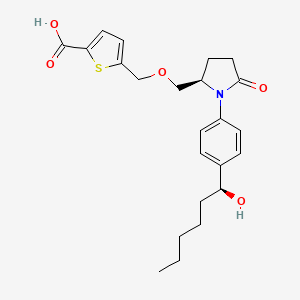
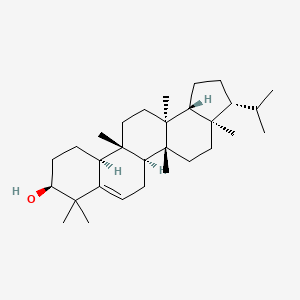
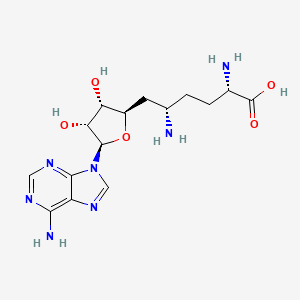
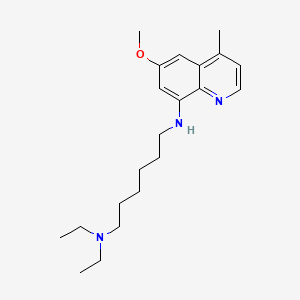
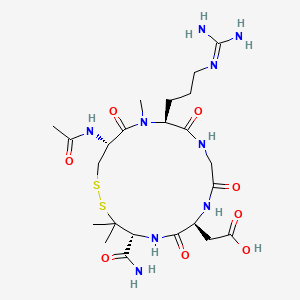
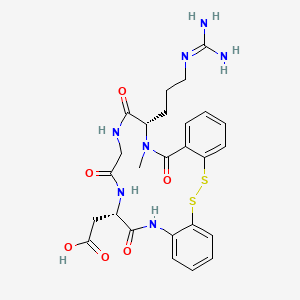
![[2-[bis[(2S)-2-aminopropanoyl]amino]-3-methylphenyl] (2S)-2-[[(2S)-2-(3-hydroxyhexanoylamino)-3-methylbutanoyl]amino]-3-methylbutanoate](/img/structure/B1681687.png)

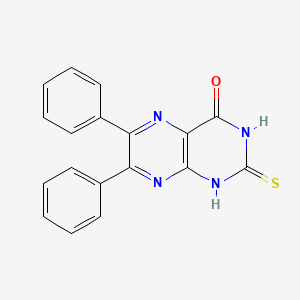
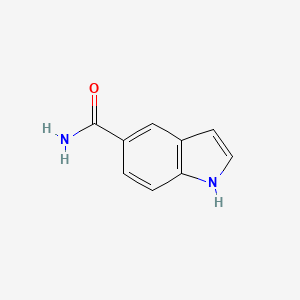
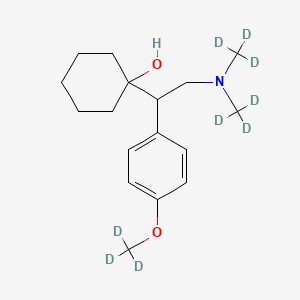
![N-hydroxy-1-(2-methoxyethyl)-4-[4-[4-(trifluoromethoxy)phenoxy]phenyl]sulfonylpiperidine-4-carboxamide;hydrochloride](/img/structure/B1681697.png)

